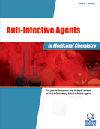- Home
- A-Z Publications
- Anti-Infective Agents in Medicinal Chemistry (Formerly Current Medicinal Chemistry - Anti-Infective Agents)
- Previous Issues
- Volume 5, Issue 3, 2006
Anti-Infective Agents in Medicinal Chemistry (Formerly Current Medicinal Chemistry - Anti-Infective Agents) - Volume 5, Issue 3, 2006
Volume 5, Issue 3, 2006
-
-
Editorial [Chemical Evolution of Natural Product Antibiotics Guest Editor: Mark L. Nelson ]
More LessAs the problem of antibiotic resistance to the major families of compounds continues, so grows the efforts and complexity of chemically modifying natural product antibiotics to combat and thwart infectious disease pathogens, the topic of this issue of Current Medicinal Chemistry, Anti-Infective Agents. As chemical modification space disappears around simpler, more synthetically amenable families, such as the β-lactams and th Read More
-
-
-
Chemoenzymatic Pathways towards Novel Peptide Antibiotics
More LessAuthors: J. Grunewald, C. Mahlert, F. Kopp and M. A. MarahielNonribosomally synthesized peptides constitute a large class of highly diverse natural products, which play an important role in modern medicine. The biological activity of these complex compounds ranges from antibiotics to immunosuppressives, cytostatics to cytotoxics, a fact that makes them attractive scaffolds for drug leads. In more recent years, chemoenzymatic strategies were developed allowing the synthesis and d Read More
-
-
-
Structural Motifs of Lipid II-Binding Lantibiotics as a Blueprint for Novel Antibiotics
More LessAuthors: Shang-Te D. Hsu, Eefjan Breukink and Robert KapteinIn the light of emerging bacterial-resistance, novel antimicrobial agents are needed to combat infectious diseases. A group of post-translationally modified peptides called lantibiotics frequently appear from screening of active natural compounds. Many lantibiotics target Lipid II, the essential precursor of bacterial cell wall synthesis. A recently characterised Lipid II-binding motif, the pyrophosphate cage, demonstrates a uniqu Read More
-
-
-
Recent Developments in the Synthesis of Novel Aminoglycoside Antibiotics
More LessAuthors: Jie Li and Cheng-Wei Tom ChangAminoglycosides represent an important resource against infectious diseases. However, the prevalence of aminoglycoside resistant bacteria has limited their clinical efficacy and prompted the renewed interest in the study of resistant mechanisms as well as the development of novel aminoglycoside antibiotics. This review will focus on the latest development in the design and synthesis of novel aminoglycoside derivatives.
-
-
-
Mitochondrial, Metabolic and Genotoxic Effects of Antiretroviral Nucleoside Reverse-Transcriptase Inhibitors
More LessAuthors: Anissa Igoudjil, Karima Begriche, Dominique Pessayre and Bernard FromentyNucleoside reverse-transcriptase inhibitors (NRTIs), including stavudine (d4T), zidovudine (AZT), didanosine (ddI), zalcitabine (ddC), lamivudine (3TC) and abacavir (ABC), inhibit/terminate the reverse transcription of the HIV virus, and markedly improve life expectancy and quality of life in HIV-infected patients. This progress, however, has come at the price of frequent side effects. NRTIs can cause myopathy, cardiomyopathy, p Read More
-
-
-
Antiviral Agents in the Prevention and Treatment of Virus-Induced Diabetes
More LessAuthors: A. S. Galabov and A. AngelovaInsulin-dependent diabetes mellitus is among the most common metabolic disorders in humans. It results from the graduate loss of function and progressive destruction of insulin-producing beta cells in the pancreatic islets of Langerhans. Several factors have been implicated in the pathogenesis of the disease, including host genetics, autoimmune responses and environmental factors. Viruses are among the environ Read More
-
-
-
Suitable Antibacterial Substances for the Treatment of Urinary Tract Infections
More LessAuthors: Florian M.E Wagenlehner and Kurt G. NaberBacterial urinary tract infections (UTIs) are frequently found in the outpatient as well as in the nosocomial setting. The bacterial UTIs can be stratified into uncomplicated and complicated UTIs. In uncomplicated UTIs Escherichia coli is the leading organism, whereas in complicated UTIs the bacterial spectrum is much broader including Gramnegative and Gram-positive organisms. Therapy of uncomplicated UTIs is almost Read More
-
Most Read This Month
Article
content/journals/aiamc
Journal
10
5
false
en


